
If you’re a fan of Japanese-flavoured, rally-bred, all-paw turbo fun that asks for reasonable money, the latest Subaru WRX STI is your guy. More so than the regular Subaru WRX.
Why? Despite drawing heavily from older powertrain tech, the new STI not only has more weapons in its speed arsenal but its well-proven oily bits feel far more evolved than those – the FA engine, redesigned six-speed – found in the ‘normal’ Rex.
More capacity, proper differentials front and rear, a trickier centre diff, more hard-core handling package and better brakes and grip are just some of the advantages. One seat-of-the-pants sprint up Victorian back country twisties confirms Subaru’s old tech obliterates its new, the STI measurably quicker and more focused.
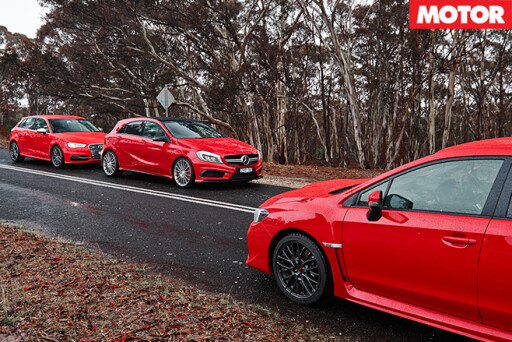 Now while that may seem a strange point to start on given the pair of Germans – and no sign of a WRX – on the pages before you, it’s a crucial one: the Japanese shine brightest when evolution, rather than revolution, is the performance brief. Bar Nissan’s GT-R, this is as hot as the land of the rising sun offers for today’s Aussie peso. Easy.
Now while that may seem a strange point to start on given the pair of Germans – and no sign of a WRX – on the pages before you, it’s a crucial one: the Japanese shine brightest when evolution, rather than revolution, is the performance brief. Bar Nissan’s GT-R, this is as hot as the land of the rising sun offers for today’s Aussie peso. Easy.
As we’ve harped on for some time, Germany has now stolen the small-car, turbo-four, all-wheel-driven march. Specifically Audi, the originator of quattro performance, and Mercedes-Benz, who rocked up virtually yesterday with its manic A45 AMG and raised the bar way up yonder.
But in the absence of a full-monty RS version of Audi’s ‘3’ range best suited to a proper challenge on the trumped-up Merc, the new S3, here in five-door hatch form, is Ingolstadt’s strongest challenger.
 Before you yell “unfair fight!”, factor in the value proposition. Thanks to a massive price cut, the STI lists at just $49,490 in base form and $55,390 for the fruitier premium model, while the S3 asks for $61,100 and the A45 wants $15K more again. So while the A45 is widely considered to be the star hot hatch performer, frankly, so it should be.
Before you yell “unfair fight!”, factor in the value proposition. Thanks to a massive price cut, the STI lists at just $49,490 in base form and $55,390 for the fruitier premium model, while the S3 asks for $61,100 and the A45 wants $15K more again. So while the A45 is widely considered to be the star hot hatch performer, frankly, so it should be.
It sure wins the stats war. Its 265kW (at 6000rpm) and 450Nm (between 2250-5000rpm) from just 2.0 litres of capacity is astonishing and makes the Audi’s 210kW (at 6500rpm) and 380Nm (from 1800rpm) from the same capacity look a little underdone and the STI’s 221kW (at 6000rpm) and 407Nm (at 4000rpm) from 2.5 litres look positively lazy. And, boy, they’re distinctly different units in character. Doubly so when you throw transmissions into the equation.
Despite its lofty peak-torque point, the larger-capacity STI is all low-to-mid range punch, its urgency flattening off towards its 6700rpm redline. On the go in the lower of the revised six-speed manual’s ratios, response is lively, its tractability urgent.

And while this would have to be the quickest-shifting and most positively gated STI ’box yet, its ratios aren’t as keenly matched to its engine’s output curves, demanding concentrated gear-rowing to keep the EJ on the boil. Sink the boot in taller gears while cruising and the STI is easily caught snoozing.
Both Germans have excellent dual-clutch gearboxes, with tightly-stacked forward ratios (six for S3, seven for A45), super-fast and super-clean upshifts and completely intuitive shelf-shifting calibrations that never seem to catch the engines off guard.
Unlike the Merc, you can have your S3 as a conventional six-speed manual, but having driven both types back-to-back the DSG is a much quicker device.
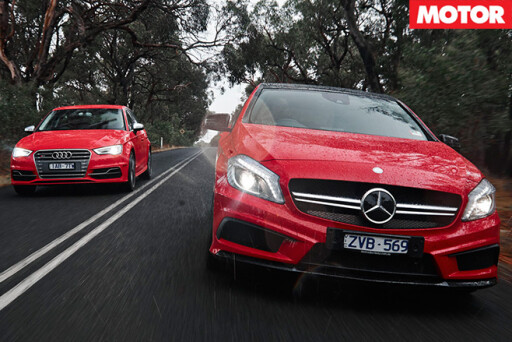 The STI has no self-shifting trans option, which is somewhat a bone of contention. Subaru pulls the ‘old-school purity’ card, plus limited budgets, as reasons for not offering a twin-clutch. Fine. But in current company the Japanese car is hamstrung not only in a straight line but, sans lightning-quick paddle shifts, generally hampered through corners too.
The STI has no self-shifting trans option, which is somewhat a bone of contention. Subaru pulls the ‘old-school purity’ card, plus limited budgets, as reasons for not offering a twin-clutch. Fine. But in current company the Japanese car is hamstrung not only in a straight line but, sans lightning-quick paddle shifts, generally hampered through corners too.
The STI’s short-comings quickly become apparent on the strip. Dial up launch control on the S3 and it marches, fuss free, to 100km/h in 4.9sec, hitting 400m in 13.2sec. Again and again, no voodoo or trickery required.
Launching the STI with all the sympathy of an axe murderer gets it off the mark a little quicker, but by 60km/h the S3’s in front, and the Subie manages just 5.6sec to 100 (not helped by needing a shift to third at 90km/h) and is half-a-second behind (13.7sec), with a slower terminal speed (164.0km/h plays 168.6), at the 400m mark.
 The most powerful and expensive car here, the A45, does as you’d expect it to, scorching to 100 in 4.6sec and nailing the 400m in a commanding 12.8sec. It takes some button fiddling with the launch control system (worth about 0.6sec in both disciplines) to get there but, well, it more than backs up its claim of being the fastest kid on the block.
The most powerful and expensive car here, the A45, does as you’d expect it to, scorching to 100 in 4.6sec and nailing the 400m in a commanding 12.8sec. It takes some button fiddling with the launch control system (worth about 0.6sec in both disciplines) to get there but, well, it more than backs up its claim of being the fastest kid on the block.
From the breath-taking initial shove off the line to the shotgun-like bark on full-throttle upshifts, everything about the AMG suggests exacting precision in getting the task done.
But it’s suddenly the S3 that’s become the comparo’s dark horse and the STI’s biggest threat in getting relegated to last place for sheer pace. Even for rolling acceleration, the STI can merely match the less powerful Audi (both 3.4sec) for 80-120km/h, the Merc a full 0.4sec swifter on the move.
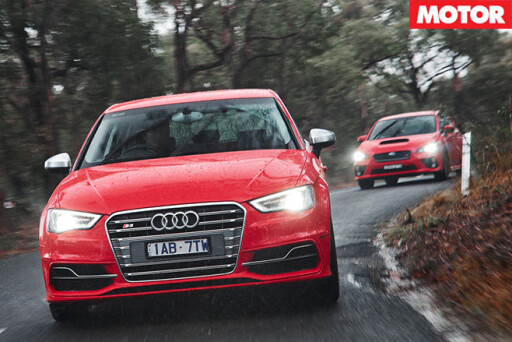 Sure, this latest STI doesn’t feel any slower than versions past, but all of this serves to highlight three points. Firstly, while the Japanese hero hasn’t moved backwards, the Germans are making huge strides forward. Secondly, having more horsepower doesn’t mean quicker pace. And, thirdly, in Subaru’s defence, the company reckons its flagship head-kicker is more about moving the handling game forward than tearing up drag strips.
Sure, this latest STI doesn’t feel any slower than versions past, but all of this serves to highlight three points. Firstly, while the Japanese hero hasn’t moved backwards, the Germans are making huge strides forward. Secondly, having more horsepower doesn’t mean quicker pace. And, thirdly, in Subaru’s defence, the company reckons its flagship head-kicker is more about moving the handling game forward than tearing up drag strips.
Throwing corners into the equation only amplifies just how different in character these three are. And it becomes much clearer that, while they share commonality in drivetrain layout, each aims to appeal at quite different sets of buyers.
On looks alone – hell, on rear wings alone, though it’s now a deletable option – you might peg the STI as aimed firmly at the youth set, but it’s probably more the case of older buyers young at heart, those to whom Subaru’s rally heritage and traditions speaks the loudest. So do the Si-Drive modes that govern (mostly) the engine’s throttle mapping, as does the ability to manually select front- or rear-drive bias if the driver so chooses.
Then there’s rally-bred mechanical diff package front and rear, techy torque vectoring (complete with a real-time torque read-out in the centre dash display), and good old-fashioned hydraulic steering with a new super-quick rack ratio. The STI, then, wants to engage the driver with its myriad go-faster geekery, encouraging them to play with dials, prod buttons and experiment with settings.
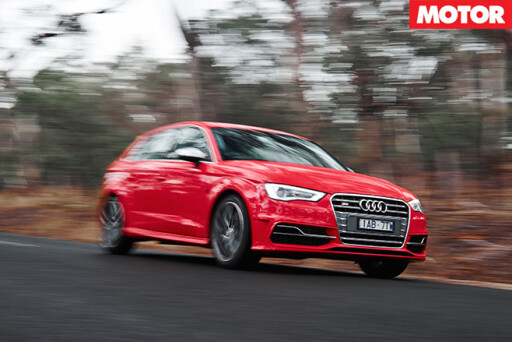 The S3 is a whole level simpler. Its quattro system is advanced in tech, but its choice of driver interaction is focused into a more slim-lined Drive Select menu that allows tailoring of engine/trans mapping, exhaust note and degrees of electric power steering assistance (in Individual). Essentially, though, you choose between ‘cruising’ or ‘kill’ and the car does the rest.
The S3 is a whole level simpler. Its quattro system is advanced in tech, but its choice of driver interaction is focused into a more slim-lined Drive Select menu that allows tailoring of engine/trans mapping, exhaust note and degrees of electric power steering assistance (in Individual). Essentially, though, you choose between ‘cruising’ or ‘kill’ and the car does the rest.
The AMG? Simpler again. Select Sport or Manual from a button on the centre console and aim it for the horizon. Both German cars use essentially front-biased all-wheel-drive systems with a high level of electronic governing, most of it out of the direct control of hands-on driver discretion.
Compared with the Subaru, their handling characters are much more prepackaged from the factory, their calibrations dictated by teams of lab coats rather than the whims of the pilot on the fly.
From the first corner, you notice vast differences in steering. The old-school hydraulic STI steering is urgent and heavily weighted off centre, positively cumbersome at low speed. But dive towards the apex and resistance lightens up, perhaps too much, and the nose suddenly feels airy and distant.
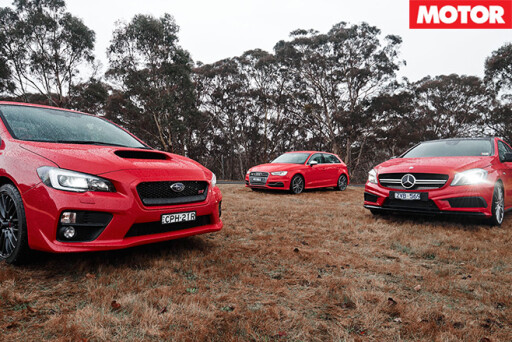 There’s plenty of genuine mechanical feel yet, weirdly, not much feedback of how loaded up the front tyres are. Push on and you’ll find understeer easily, but bury the right foot harder and that front diff piles just the right amount of torque across the front axle and into the road surface, tightening the line on the corner’s exit.
There’s plenty of genuine mechanical feel yet, weirdly, not much feedback of how loaded up the front tyres are. Push on and you’ll find understeer easily, but bury the right foot harder and that front diff piles just the right amount of torque across the front axle and into the road surface, tightening the line on the corner’s exit.
Manually winding the centre diff to a rear-bias offers a mild, grin-inducing oversteer state under full noise and there’s certainly plenty of oh-so-joyous Subaru balance in the mid corner with a constant throttle.
But up the pace and it’s easily upset by torque shuffling around all four corners of the chassis, the all-paw system feeling much more reactive than proactive when dancing around at the edges of adhesion. Fun? You bet.
But the grip available from the fattest tyres here (245mm) is surprisingly modest. And the Subie is left bucking and shimmying around in corners as either German comes looming up in the rear-view mirror.
The Audi’s heavier Dynamic steering mode doesn’t add much feel. Nor does it need to. The S3 has much more clarity and linearity in its front end and can be more accurately and confidently placed.
Better yet, its quattro system shuffles torque to each wheel where and when it’s needed with more finesse. Less theatrics, more pace. Of the three here it’s certainly the most composed, the easiest to punt hard, and the best car for modest driving skills.
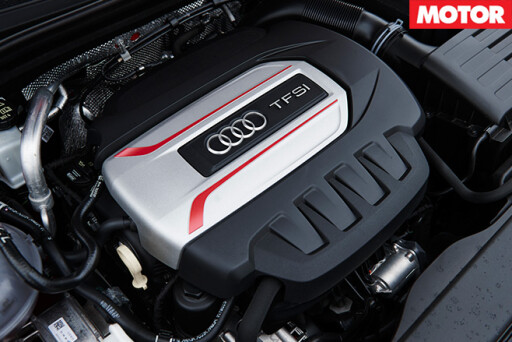 And despite offering less outright road-holding grip from its narrower 225mm rubber than the STI, it’s swifter from point A to point B. Much of that is down to the chassis not becoming so upset to grab-it-by-the-scruff steering/throttle/braking inputs.
And despite offering less outright road-holding grip from its narrower 225mm rubber than the STI, it’s swifter from point A to point B. Much of that is down to the chassis not becoming so upset to grab-it-by-the-scruff steering/throttle/braking inputs.
Thing is, the Audi is only really lively on lift-off – it takes lateral weight shifts, rather than a firm throttle prod, to get that tail moving. A more rearward torque bias and a fatter rubber footprint would inject the S3 with some welcome fun factor.
The AMG is the tightest, tautest and edgiest car of the three. And ‘edgiest’ doesn’t mean edge of disaster either. In fact, quite the opposite. The steering is crisper and offers a tad more precision than the Audi, its front end immensely grippy.
And it takes extreme foolhardiness to get the thing to understeer; few other cars out there with 235mm tyres – whatever the driven wheels – point with such precision.
That hunkered-down feeling of tightness continues to the mid-corner and corner exit. It feels the most agile in direction changes and the most willing to adjust its line.
 It’s as effusive exiting corners under full power as the STI, yet it doesn’t feel the case because it’s much more linear and contained in its delivery. Like the Audi, the Merc could be a little more playful but, frankly, at 10-10ths you’re going so quick that any dynamic theatrics are simply going to slow you down. Then there are its brakes.
It’s as effusive exiting corners under full power as the STI, yet it doesn’t feel the case because it’s much more linear and contained in its delivery. Like the Audi, the Merc could be a little more playful but, frankly, at 10-10ths you’re going so quick that any dynamic theatrics are simply going to slow you down. Then there are its brakes.
The A45’s are so robust, powerful and brimming with feel that you can dive much deeper into corners, regardless of camber or surface. The Audi’s stoppers are very handy too, and both Germans seem to sit flatter when turning in under brakes.
Braking from 100km/h to rest in torrential rain, the STI’s four-pot fronts gave it the slight edge over the single-piston Audi, stopping in 39.6m versus the S3’s 40.6m. As for the Merc, it appeared to ignore the wet, its huge four-piston front jobbies bringing the A45 to a halt in just 35.5m. Add easily the most sport focused seats of the three and one verdict is clear: if going fast is your game and money is no object, the A45 is the tool for the job. Easily.
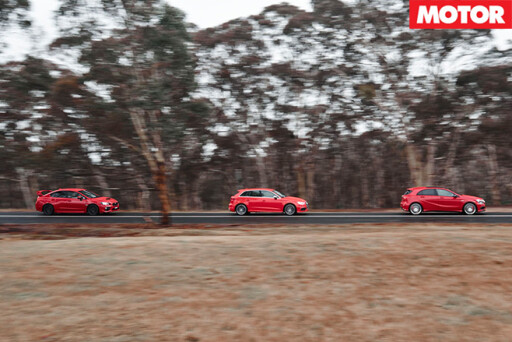 But choosing a winner here is more complicated. While the A45 is wickedly fast, the S3 is certainly no slouch. And when you’re paying $75K for a small car, it’d want to be multifaceted rather than just simply being quick. These are everyday drivers for those who buy them.
But choosing a winner here is more complicated. While the A45 is wickedly fast, the S3 is certainly no slouch. And when you’re paying $75K for a small car, it’d want to be multifaceted rather than just simply being quick. These are everyday drivers for those who buy them.
The AMG isn’t hard to live with, but the S3 strikes a superior balance between comfortable normal driving manners and on-command rocketship ability. And while the AMG is the acceleration king, the S3 isn’t left behind by much. There’s fair argument the AMG is worth its lofty price-tag, but there’s an equal one that the S3 is something of a bargain.
Despite its sharp new price, the STI can’t quite convert its $10K benefit into superior all-round value. Inside, the Audi is two rungs above the Subaru in every way: beautiful heated electric seats versus cheaper mechanical pews; premium infotainment/sat-nav with dial centre-console interface versus clunky ’00s-esque touchscreen arrangement; real alloy versus fake plastic... the list goes on.
 The Audi rides best, has the best noise isolation and is the easiest car to live with for 90 per cent of the commuting most buyers will use these cars for. It’s also the most useable and fuel efficient, yet has a level of performance the STI can’t match, at least away from a racetrack.
The Audi rides best, has the best noise isolation and is the easiest car to live with for 90 per cent of the commuting most buyers will use these cars for. It’s also the most useable and fuel efficient, yet has a level of performance the STI can’t match, at least away from a racetrack.
It mightn’t scream heroics like its rivals, but the S3 is a bloody hard car to fault. And the car this judge grabbed the keys to when the dust settled. Nice job Audi.
| Mercedes-benz A45 AMG | Subaru WRX STI | Audi S3 | |||
| 4 out of 5 stars | 4 out of 5 stars | 4 out of 5 stars | |||
| Body | 5-door, 5-seat hatch | 4-door, 5-seat sedan | 5-door, 5-seat hatch | ||
| Drive | all-wheel | all-wheel | all-wheel | ||
| Engine | 1991cc inline-4, DOHC, 16v, turbo | 2457cc flat-4, DOHC, 16v, turbo | 1984cc inline-4, DOHC, 16v, turbo | ||
| Bore/stroke | 83.0 x 92.0mm | 99.5 x 79mm | 82.5 x 92.8mm | ||
| Compression | 8.6:1 | 8.2:1 | 9.3:1 | ||
| Power | 265kW @ 6000rpm | 221kW @ 6000rpm | 206kW @ 5100-6500rpm | ||
| Torque | 450Nm @ 2250-5000rpm | 407Nm @ 4000rpm | 380Nm @ 1800-5100rpm | ||
| Power/weight | 179kW/tonne | 145kW/tonne | 143kW/tonne | ||
| Consumption | 12.8L/100km (tested) | 13.0L/100km (tested) | 10.2L/100km (tested) | ||
| CO2 emissions | 304g/km (tested) | 309g/km (tested) | 243g/km (tested) | ||
| Transmission | 7-speed dual-clutch | 6-speed manual | 6-speed dual-clutch | ||
| Weight | 1480kg | 1525kg | 1445kg | ||
| Suspension | struts, coil springs, anti-roll bar (f); multi-links, coil springs, anti-roll bar (r) | A-arms, struts, coil springs, anti-roll bar (f) multi-link, coil springs, anti-roll bar (r) | A-arms, struts, coil springs, anti-roll bar (f); multi-links, coil springs, anti-roll bar (r) | ||
| L/W/H | 4359/1780/1417mm | 4595/1796/1476mm | 4324/1785/1404mm | ||
| Wheelbase | 2699mm | 2649mm | 2631mm | ||
| Tracks | 1557/1561mm (f/r) | 1529/1539mm (f/r) | 1535/1511mm (f/r) | ||
| Steering | electrically-assisted rack and pinion | hydraulically-assisted rack and pinion | electrically-assisted rack and pinion | ||
| Brakes | 350mm ventilated/drilled discs, 4-piston calipers (f); 330mm ventilated/drilled discs, single-piston calipers (r) | 330mm ventilated discs, 4-piston calipers (f); 315mm ventilated discs, 2-piston calipers (r) | 340mm ventilated discs, single-piston calipers (f); 310mm ventilated discs, single-piston calipers (r) | ||
| Wheels | 19 x 8.0-inch (f/r) | 18 x 8.5-inch (f/r) | 18 x 7.5-inch (f/r) | ||
| Tyres | 235/35 ZR19 97Y Dunlop Sport Maxx (f/r) | 225/40 R18 97W Dunlop Sport Maxx (f/r) | 225/40 R18 92Y Continental ContiSportContact5 (f/r) | ||
| Price | $74,990 | $49,990 | $59,900 | ||
| Price as Tested | $74,990 | $49,990 | $62,350* Metallic paint $1050; 5 twin-spoke wheel design $500; Audi Design Select red trim $900 | ||
| Positives | Incredible performance, brilliant chassis, awesome brakes | Handling balance and adjustability; sharp new price | Cracking drivetrain; brilliant interior; the everyday choice | ||
| Negatives | Pricey, lacks some everyday comfort, thirsty | No quicker than the last car; doesn’t move the game forward | Conservative looks; needs a bit more fun factor | ||

COMMENTS